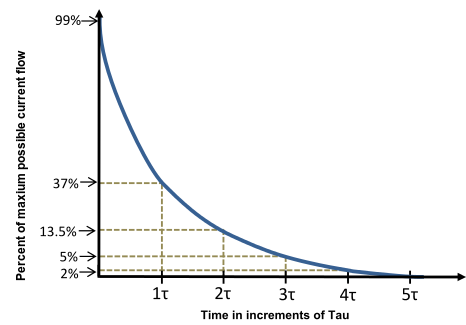Inductive Flyback and Flyback Diodes
Introduction
Inductive flyback refers to the voltage spike created by an inductor when its power supply is suddenly reduced or removed. This voltage spike occurs because the current flowing through the inductor cannot change instantly. The rate at which the current can change is limited by the inductor's time constant. This is very similar to how a capacitor's time constant limits the rate at which voltage can change across its terminals.
Origin of the Voltage Spike
In order to understand why inductive flyback occurs, you must first consider the inductor's time constant. As previously stated, an inductor's time constant limits how fast the current can change. The time constant can be calculated with the following equation:
$\large \tau = \frac{L}{R}$
Where L is the inductance in Henries, and R is the resistance present in the circuit. For our purposed, we care about how fast the current can decrease (dissipate) once the inductor has been disconnected. The amount of current that can be dissipated within 5 time constants is illustrated in Fig. 1 below.
Based on the time constant equation and the curve from Fig. 1, we can get a pretty good idea of how fast an inductor's current will change in a real world situation.
For example, let's say we have a 10 H inductor in series with a 10 Ω resistor, as seen in Fig. 2. We will assume the switch in the circuit has been closed long enough to allow the maximum amount of current to flow through the inductor.
Next, let's say we suddenly open the switch, as shown in Fig. 3.
To find out what happens to the current in our circuit over the next few seconds we can use the time constant. With a quick calculation we find that τ is equal to one second. Referring back to Fig. 1 we can see that it will take one second (one increment of τ) for the current to decrease from 99% to 37%. To go from 99% to 15.5%, it will take two seconds (two increments of τ). Overall , it will take a total of about 5 seconds for the current flow to completely stop once the switch has been opened.
At first glance this might make sense, but when you really think about it things don't seem to add up. Realistically, the time it takes for the switch to completely disconnect from the circuit is much faster than the 5 seconds. This implies that current would continue to flow while the switch is open, which is impossible in the circuit model we have setup. In reality, the inductor will do everything it can to keep the current flowing according to its dissipation curve. This means there is some factor we are missing in our circuit model which we need to account for.
From the inductors point of view, the circuit gap (typically made of air) looks like a VERY big resistor. To account for this, we will place a 40,000,000 M Ω resistor across the gap, as seen in Fig. 4. The magnitude of the gap resistor is fairly accurate since air can have trillions of ohms of electrical resistance.
Now that the electrical resistance of the switch gap has been accounted for, it appears we have a complete circuit for the current to flow through. While this may be true, recall that every resistor needs a voltage drop for current to flow. Unfortunately, before the switch was opened the top terminal of the inductor was at the same voltage as the power source. This means that the current will still not flow, even though it has a path to follow (see Fig. 4).
Despite this, the inductor will do everything it can to make the current match its dissipation curve. In order to keep current flowing the inductor will create a voltage drop across the resistor by switching its polarity, as seen in Fig. 5. It does this by using the energy that was stored in its magnetic field.
Although there is now a voltage drop across the gap resistor, the current will still not flow at the rate the inductor wants. Initially, the inductor wants the current to be at 99% of what was flowing before the switch was opened. Considering Ohm's law and the magnitude of the gap resistor, this could prove problematic. Recall Ohm's law is:
$\large V = I\times R$
Multiplying even the tiniest current by such a large resistance will result in a huge voltage. In order to achieve this large voltage drop, the inductor will use the remainder of its stored energy to create a very large negative potential on one side of the gap resistor (see Fig. 5). This ensures that current will flow according to the dissipation curve. This is ultimately the origin of the flyback voltage spike.
Consequences of Flyback Voltages
The flyback voltage generated by inductive loads can potentially damage the component being used to open and close the circuit. In the case of a physical switch, an electrical spark/arc will occur. The size and lifespan of the arc will depend on the power supply voltage, RL time constant, and the size of the switch gap. Most of the time the arc is much too small or fast to be noticed; however, under the right circumstances it can be quite spectacular. We have provided a video link of a flyback arc at a 500 KV power line substation, which can be found below.
It is worthy to note that this impressive arc does not occur simply because a switch was opened in a 500 KV circuit. Near the end of the video you can see, once the switch has been fully opened, the arc persists for a few seconds then disappears. Once the arc is gone there is still a 500 KV voltage drop across the switch terminals. Despite this, no further arcing occurs. This is because the arc was actually a result of the flyback generated by a few massive inductors contained within the substation's “line reactor”.
In the video's description, the author identifies the line reactor as “the huge gray transformer-like object behind the truck at the far right at the end of the clip”. He goes on to describe how the line reactor is made of “large iron core coils (inductors) which are used to counteract the effects of line capacitance on long Extra High Voltage (EHV) transmission lines”. Even though the inductors in the line reactor are meant to reduce capacitance between power lines, they still follow the same basic inductor rules. When the substation switches are flipped, the current in the circuit tries to abruptly change. As a direct result, the inductors in the line reactor respond with a tremendous voltage spike creating the huge arc. When working with such large voltages and inductors, inductive flyback is difficult to prevent. Fortunately, when working with smaller circuits there are simple ways of preventing any flyback from occurring.
Preventing Flyback with Diodes
To eliminate the possibility of a switching device (such as a transistor) from being damaged by inductive flyback, you can use a flyback diode. The idea behind a flyback diode is it gives a path for the current to flow through once the inductor has been disconnected. Figure 6 depicts our previous circuit with the addition of a flyback diode.
Notice that the polarity of the diode is opposite of the power supply polarity. This ensures that when the switch is closed the diode is reverse biased. While reverse biased, the diode will not let any current through, and therefore, has zero effect on the rest of the circuit.
When the switch is opened, the inductor will reverse its polarity and the diode will be forward biased. While forward biased, the diode will allow current to flow through and dissipate at the rate the inductor wants. This is illustrated in Fig. 7 below.
As you can see, the addition of the diode gives a path for the current to flow. Since diodes have almost no resistance when forward biased, the inductor only has to make a very small voltage drop to get the correct amount of current to flow. This prevents the switching device from arcing or being damaged. It is important to note that the diode's polarity must be opposite of the power supply. This ensures that when the switch is closed the diode will have no effect on the circuit (essentially looking like an open circuit). This also means that when the switch is open, the diode's polarity will match the inductors reversed polarity and prevent a serious flyback voltage spike.







